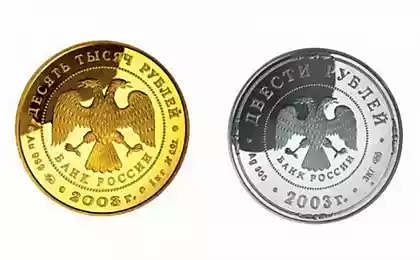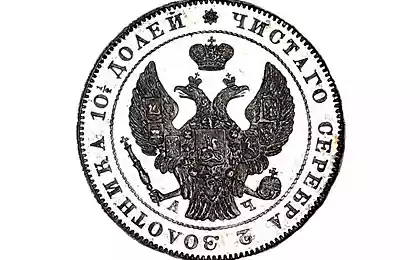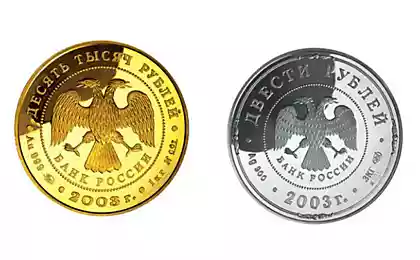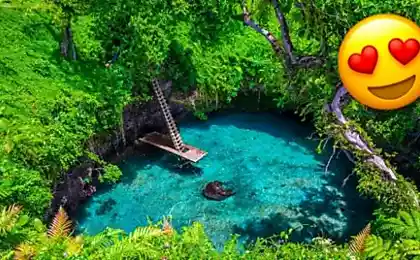927
The most expensive coin
Which coins are worth much more expensive than face value.
50 cents in 1929 - 10 million rubles
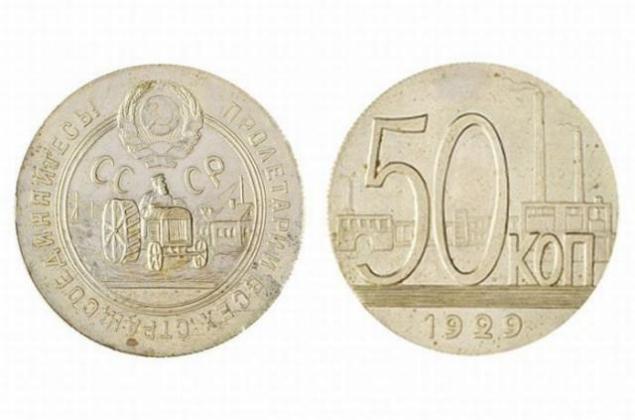
There are coins that are solid puzzle. After the collapse of the NEP, the Soviet government conceived to go to the minting of copper-nickel coins of silver in return. Silver - Monetary metal - was required for the needs of industrialization. To people do not hoard silver detail, the reform was prepared in secret (to surviving documents is classified as "top secret"). In 1931, the Soviet Union were in circulation copper-nickel 10, 15 and 20 cents. Coins 1 ruble and 50 kopecks, it was decided no mint.
The archive of the Leningrad Mint preserved the stamp tool probe 10 and 50 cents, but not a single sample of the coins themselves. However, a few years ago in a private collection I showed fifty dollars - the only known copy of the trial to date of minting in 1929. In May 2011, at an auction, "Znak" it was sold to the buyer, making a bet on the phone for 10 million rubles. This is a record price for Russian or Soviet coin for the last three years.
12 rubles in 1836 - 4, 65 million rubles
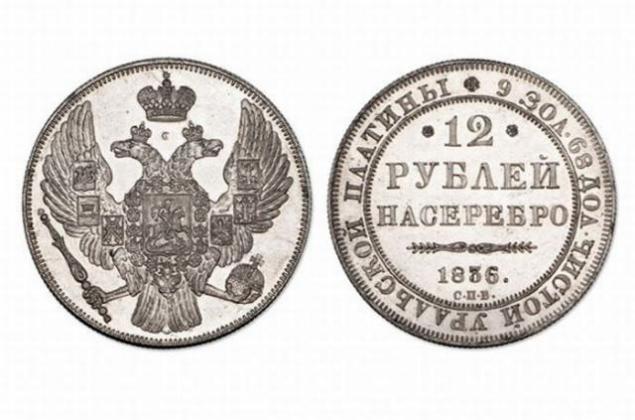
The Russian Empire was the only country, released for circulation coins made of platinum. Platinum 3, 6 and 12 rubles were minted from 1828 to 1845 years of fairly large editions, several thousand units per year. But some coins known in a few years copies - presumably, they coined in the second half of the XIX century by order of wealthy collectors. For example, 12-rublevok with the date 1836 was issued only eleven.
At the auctions, they appear very rarely, and always grow in value. Thus, in December 2010 at auction house Bonhams auction of British 12 rubles 1836 "left" for $ 96 000 (about 3 million). And last April, the same coin at auction Moscow firm "Coins and Medals" has already sold for 4, 65 million rubles.
25 rubles in 1908 - 1, 9 million rubles
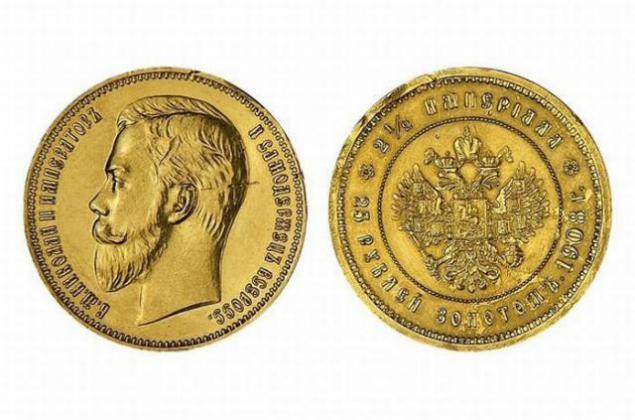
At the beginning of the XX century in Siberia in the imperial mines it was found five-kilogram gold nugget. Nicholas II wanted to make him a coin for gifts relatives and in celebration of its 40th anniversary in 1908. Nugget enough for 150 gold. Later, by the order of Grand Duke Georgy Mikhailovich, a passionate collector, another 25 were minted such coins.
25 rubles in 1908 are considered very rare, however, for the last year and a half, they exhibited at Russian and foreign auctions five times. In April 2011, at an auction, "Imperiya" 25-Ruble is not a better safety - with nicks and scratches - sold for 1, 9 million rubles. In perfect condition, without any damage, it would cost twice as much.
5 cents in 1916 - 1, 6 million rubles

Trial coins with date 1916 - the last witnesses and failed monetary reform in the Russian Empire. During World War II, the purchasing power of the ruble dropped significantly, began to disappear from circulation, settling in "stashes" as silver coins and copper coins. Copper coins of the new sample (1, 2, 3 and 5 cents) is supposed to do half the weight of those that were in circulation. Revolution buried this project. How much it was made "probes" - unknown.
In 1927, the Leningrad Mint coined authentic stamps for a number of coins for sale to collectors. Nevertheless, they are still considered rare. In April this year, 5 cents of a trial series in 1916 were sold at auction "Coins and Medals" for 1, 6 million rubles. In autumn 2010, exactly the same patch of "left" bid for 1, 3 million rubles.
1 ruble 1806 - 1, 55 million rubles

Emperor Alexander I, who ascended the throne, inexplicably refused to mint coins with his portrait. Not that he did not like your own profile - known award medals with portraits of the same monarch, as in the trial rublevikah. But they have remained tentative. In the middle of the XIX century St. Petersburg Mint produced a replica of ordered several varieties of these coins (according to the documents - no less than 30 pieces). One of them - with a portrait of Alexander I in the uniform of the Guards and an eagle on the back - on the last trading "of coins and medals", "left" for 1, 55 million rubles. If the seller bought the coin on the eve of the crisis, much lost. In 2007, the price of a "probe" reached 2 million rubles.
1 ruble 1705 - 1, 5 million rubles

Prior to the 1730s, when they were discovered rich gold mines in the Altai, Russia did not have a silver - coins were minted from imported metal. In 1704, on the initiative of Peter I in Moscow began to produce silver rubles on the model of Western European talers. These coins served as raw material for coinage. The first time they happen to be melted down and sent directly under the press.
At the auction, "Coins and Medals" exhibited an interesting copy of the ruble - a coin in 1705, from the Polish perechekanennaya thaler 1630 (and an error in the writing of the new date - a rare variety of stamps). Its price during the bidding rose to 1, 5 million rubles, while the ruble of the same year the ordinary coinage was sold for 400 000 rubles.
1 ruble 1861 - 1, 4 million rubles

Numismatists as any collectors who appreciate the preservation of what is collected. The ideal condition of the coin - proof, the first impression of the stamp on the polished workpiece - in itself is a rarity. Rouble 1861 proof on the April auction "Russian Numismatic home" was sold for $ 1, 4 million rubles. Buyer pays for a unique condition of the coin.
Rubles in 1861 were minted more than 70 000 units, in the state of proof - very few. Last time this coin was exhibited at the prestigious German auction Gorny & Mosch in 2005. Someone was able to buy it for just € 5250 (about 180 000).
Collectors again leave good money at auction. In April-May this year the Moscow auction of five companies - "Coins and Medals", "Znak", "Alexander", "Russian Numismatic home" and "Imperiya" - coins sold about 140 million rubles. The economic crisis has adjusted prices on the numismatic market. According to the director and co-owner of the firm "Coins and Medals" Igor Lavruka, bargains time has not passed yet.
However, some coins in the auction can be a struggle, as a result of the price well above the estimate.
The owner of "Znak" Ilya Goryanov also notes that the prices of many collectible coins is low. However, it concerns relatively simple, common items - from a few thousand to tens of thousands of rubles per coin. The prices for rarities returned to pre-crisis levels. Lavruk says, the market there is a shortage of rare coins. Goryanov adds that now trades "run the show" collectors who need things in excellent condition and is very rare.
That's a reason to dismantle the coins at home parent)))
50 cents in 1929 - 10 million rubles

There are coins that are solid puzzle. After the collapse of the NEP, the Soviet government conceived to go to the minting of copper-nickel coins of silver in return. Silver - Monetary metal - was required for the needs of industrialization. To people do not hoard silver detail, the reform was prepared in secret (to surviving documents is classified as "top secret"). In 1931, the Soviet Union were in circulation copper-nickel 10, 15 and 20 cents. Coins 1 ruble and 50 kopecks, it was decided no mint.
The archive of the Leningrad Mint preserved the stamp tool probe 10 and 50 cents, but not a single sample of the coins themselves. However, a few years ago in a private collection I showed fifty dollars - the only known copy of the trial to date of minting in 1929. In May 2011, at an auction, "Znak" it was sold to the buyer, making a bet on the phone for 10 million rubles. This is a record price for Russian or Soviet coin for the last three years.
12 rubles in 1836 - 4, 65 million rubles

The Russian Empire was the only country, released for circulation coins made of platinum. Platinum 3, 6 and 12 rubles were minted from 1828 to 1845 years of fairly large editions, several thousand units per year. But some coins known in a few years copies - presumably, they coined in the second half of the XIX century by order of wealthy collectors. For example, 12-rublevok with the date 1836 was issued only eleven.
At the auctions, they appear very rarely, and always grow in value. Thus, in December 2010 at auction house Bonhams auction of British 12 rubles 1836 "left" for $ 96 000 (about 3 million). And last April, the same coin at auction Moscow firm "Coins and Medals" has already sold for 4, 65 million rubles.
25 rubles in 1908 - 1, 9 million rubles

At the beginning of the XX century in Siberia in the imperial mines it was found five-kilogram gold nugget. Nicholas II wanted to make him a coin for gifts relatives and in celebration of its 40th anniversary in 1908. Nugget enough for 150 gold. Later, by the order of Grand Duke Georgy Mikhailovich, a passionate collector, another 25 were minted such coins.
25 rubles in 1908 are considered very rare, however, for the last year and a half, they exhibited at Russian and foreign auctions five times. In April 2011, at an auction, "Imperiya" 25-Ruble is not a better safety - with nicks and scratches - sold for 1, 9 million rubles. In perfect condition, without any damage, it would cost twice as much.
5 cents in 1916 - 1, 6 million rubles

Trial coins with date 1916 - the last witnesses and failed monetary reform in the Russian Empire. During World War II, the purchasing power of the ruble dropped significantly, began to disappear from circulation, settling in "stashes" as silver coins and copper coins. Copper coins of the new sample (1, 2, 3 and 5 cents) is supposed to do half the weight of those that were in circulation. Revolution buried this project. How much it was made "probes" - unknown.
In 1927, the Leningrad Mint coined authentic stamps for a number of coins for sale to collectors. Nevertheless, they are still considered rare. In April this year, 5 cents of a trial series in 1916 were sold at auction "Coins and Medals" for 1, 6 million rubles. In autumn 2010, exactly the same patch of "left" bid for 1, 3 million rubles.
1 ruble 1806 - 1, 55 million rubles

Emperor Alexander I, who ascended the throne, inexplicably refused to mint coins with his portrait. Not that he did not like your own profile - known award medals with portraits of the same monarch, as in the trial rublevikah. But they have remained tentative. In the middle of the XIX century St. Petersburg Mint produced a replica of ordered several varieties of these coins (according to the documents - no less than 30 pieces). One of them - with a portrait of Alexander I in the uniform of the Guards and an eagle on the back - on the last trading "of coins and medals", "left" for 1, 55 million rubles. If the seller bought the coin on the eve of the crisis, much lost. In 2007, the price of a "probe" reached 2 million rubles.
1 ruble 1705 - 1, 5 million rubles

Prior to the 1730s, when they were discovered rich gold mines in the Altai, Russia did not have a silver - coins were minted from imported metal. In 1704, on the initiative of Peter I in Moscow began to produce silver rubles on the model of Western European talers. These coins served as raw material for coinage. The first time they happen to be melted down and sent directly under the press.
At the auction, "Coins and Medals" exhibited an interesting copy of the ruble - a coin in 1705, from the Polish perechekanennaya thaler 1630 (and an error in the writing of the new date - a rare variety of stamps). Its price during the bidding rose to 1, 5 million rubles, while the ruble of the same year the ordinary coinage was sold for 400 000 rubles.
1 ruble 1861 - 1, 4 million rubles

Numismatists as any collectors who appreciate the preservation of what is collected. The ideal condition of the coin - proof, the first impression of the stamp on the polished workpiece - in itself is a rarity. Rouble 1861 proof on the April auction "Russian Numismatic home" was sold for $ 1, 4 million rubles. Buyer pays for a unique condition of the coin.
Rubles in 1861 were minted more than 70 000 units, in the state of proof - very few. Last time this coin was exhibited at the prestigious German auction Gorny & Mosch in 2005. Someone was able to buy it for just € 5250 (about 180 000).
Collectors again leave good money at auction. In April-May this year the Moscow auction of five companies - "Coins and Medals", "Znak", "Alexander", "Russian Numismatic home" and "Imperiya" - coins sold about 140 million rubles. The economic crisis has adjusted prices on the numismatic market. According to the director and co-owner of the firm "Coins and Medals" Igor Lavruka, bargains time has not passed yet.
However, some coins in the auction can be a struggle, as a result of the price well above the estimate.
The owner of "Znak" Ilya Goryanov also notes that the prices of many collectible coins is low. However, it concerns relatively simple, common items - from a few thousand to tens of thousands of rubles per coin. The prices for rarities returned to pre-crisis levels. Lavruk says, the market there is a shortage of rare coins. Goryanov adds that now trades "run the show" collectors who need things in excellent condition and is very rare.
That's a reason to dismantle the coins at home parent)))
